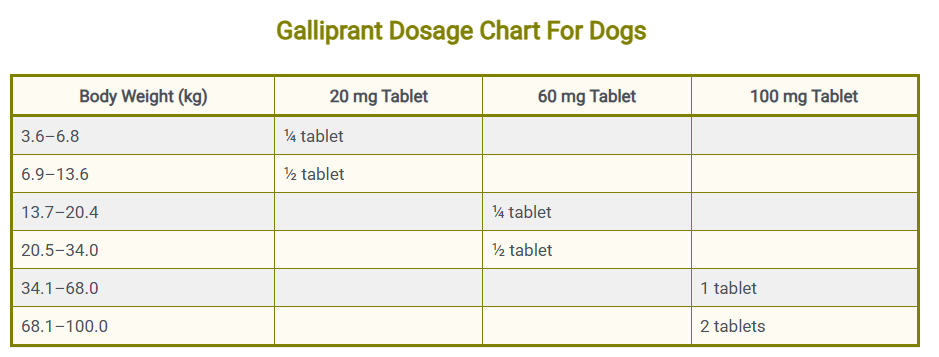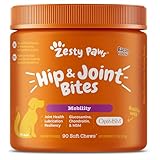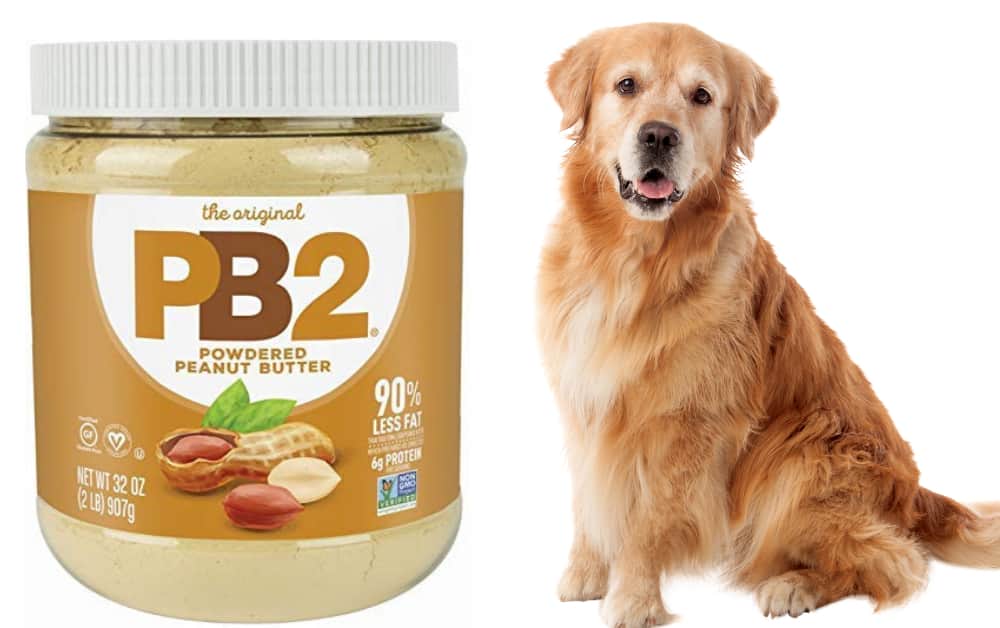Galliprant for dogs (grapiprant) is a relatively new medication specifically designed to treat pain and inflammation in dogs, especially due to osteoarthritis. Unlike traditional non-steroidal anti-inflammatory drugs (NSAIDs), Galliprant belongs to a unique class called piprant.
What makes it stand out is its ability to specifically target the EP4 receptor, which is one of the main receptors involved in canine pain and inflammation.
By doing so, it avoids blocking other prostaglandins that are important for normal body functions like kidney health, stomach protection, and blood flow regulation.
Many pet parents are relieved to find a medication that’s both effective and has fewer side effects compared to older NSAIDs. Approved by the FDA for use in dogs, Galliprant is available only with a veterinarian’s prescription and has been lauded for its safety profile, particularly in long-term use.
Disclaimer: All the information in this article is for educational purposes only and should never replace your veterinarian’s advice. Galliprant’s safety has not been studied in dogs with heart disease, those under 9 months of age, or those weighing less than 8 lbs.
Galliprant For Dogs Dosage
The recommended dosage of GALLIPRANT (grapiprant tablets) for dogs is 0.9 mg per pound (2 mg per kilogram) of body weight, given once daily.
- Tablet Strengths: Only the 20 mg and 60 mg tablets are scored (have a dividing line) and can be split for accurate dosing.
- Dosing Precision: Adjust the dose in half-tablet increments based on your dog’s weight.
- Weight Restrictions: Grapiprant cannot be accurately dosed for dogs weighing less than 8 lbs (3.6 kg) due to tablet size limitations.
Galliprant Dosage Chart For Dogs
| Dog Weight (kg) | Dog Weight (lb) | 20 mg Tablet | 60 mg Tablet | 100 mg Tablet |
|---|---|---|---|---|
| 3.6–6.8 | 8-15 | ¼ tablet | ||
| 6.9–13.6 | 15.1-30 | ½ tablet | ||
| 13.7–20.4 | 30.1-45 | ¼ tablet | ||
| 20.5–34.0 | 45.1-75 | ½ tablet | ||
| 34.1–68.0 | 75.1-150 | 1 tablet | ||
| 68.1–100.0 | 150.1-220 | 2 tablets |
The 100 mg tablet is not scored and should not be broken in half.
How Galliprant Works in Dogs
Galliprant works by selectively blocking the EP4 receptor. In simpler terms, think of it as switching off a very specific pain channel in your dog’s body, without touching the others that keep things like digestion and kidney function running smoothly. Traditional NSAIDs can be like using a hammer where a scalpel is needed—they reduce inflammation, but at a cost to the dog’s overall health because they block all COX enzymes indiscriminately.
This selective action means grapiprant reduces pain and inflammation directly associated with arthritis, allowing your dog to move more freely without suffering unwanted digestive or renal side effects. Over time, this can mean fewer vet visits, less worry for you, and more tail-wagging joy for your pup.
The result is a medication that balances effectiveness with a reduced risk of complications, especially critical in senior dogs or those with pre-existing conditions.
Benefits of Using Galliprant For Dogs
The most obvious benefit? Pain relief. But dog Galliprant does much more than that. For one, it allows your dog to return to their daily activities – playing, walking, jumping, and running – with minimal discomfort. This is especially important for aging dogs, where even a short walk might seem daunting due to arthritic pain.
Another key benefit is safety. Since Galliprant does not inhibit COX enzymes responsible for gut protection or kidney function, it’s considered a safer long-term option. It can be used in canines that might not tolerate other NSAIDs, giving pet owners peace of mind. Also, it works well with other therapies like joint supplements, physical therapy, and even certain diets.
Plus, Galliprant acts fast. Many dog owners report seeing improvement within just a few days of starting treatment. Combined with its once-daily dosing, it’s both convenient and effective.
When is Galliprant Prescribed?
Galliprant is primarily prescribed in canines for managing pain and inflammation associated with osteoarthritis. However, its use isn’t strictly limited to that condition. Dogs suffering from other forms of joint pain, inflammation, or degenerative joint diseases can also benefit.
Sometimes vets may prescribe it as part of a recovery plan post-surgery to keep inflammation under control and to help the dog feel more comfortable.
Dogs with mobility issues due to old age or chronic joint problems are common candidates. It’s especially beneficial in dogs who can no longer tolerate NSAIDs due to gastrointestinal issues or kidney concerns.
Signs Your Dog Might Need Galliprant
How do you know if your furry friend might benefit from Galliprant? Keep an eye out for these signs:
- Difficulty standing up or lying down
- Limping or stiffness after rest
- Decreased interest in walks or playtime
- Whining or restlessness, especially at night
- Reduced appetite or personality changes due to discomfort
If your dog used to zoom around the yard and now struggles to climb the stairs, that’s a red flag. These subtle behavior changes can indicate underlying pain that warrants veterinary evaluation.
Grapiprant can significantly improve quality of life if these issues are tied to inflammation or arthritis.
How Vets Decide on Prescribing Galliprant
Veterinarians take a full history and perform a physical exam to assess your dog’s condition. They may run blood work or take x-rays to confirm arthritis or joint issues. If your dog has shown intolerance to other NSAIDs, or if blood tests reveal early signs of kidney or liver issues, Galliprant may be chosen for its safety.
Dosage is also based on weight and overall health, which is why it’s crucial that Galliprant only be given under a vet’s supervision. Combining Galliprant with other supportive treatments like joint supplements or omega-3 fatty acids is also common for a holistic approach to pain management.
Best Practices for Giving Dog Galliprant
Administering Galliprant correctly is key to ensuring it works effectively for your canine. One of the perks of this medication is that it doesn’t have to be given with food. That’s right—no need to disguise it in cheese or peanut butter unless your dog is exceptionally picky.
However, many vets do suggest offering it with a small treat to help minimize any chance of stomach upset, especially during the early stages of treatment.
The medication comes in chewable tablets, making it easier for most canines to consume willingly. Still, dogs have preferences, and if your pup spits out tablets, consider hiding them in their favorite snack.
Just avoid fatty meals, as these could slow down the absorption process.
It’s best to give Galliprant at the same time every day. This keeps the levels consistent in your dog’s system, offering steady pain relief.
If your furyy firend is on other medications, make sure to discuss timing with your vet—some drugs may need to be spaced out to avoid interactions.
What to Do If You Miss a Dose
Life gets busy, and sometimes a dose gets skipped. If you forget to give grapiprant, don’t panic. The general rule is: give the missed dose as soon as you remember. However, if it’s already close to the next scheduled dose, skip the missed one.
Do not double up on doses to “catch up.” That’s a fast track to potential side effects.
Consistency is important, though. Regularly missing doses could reduce the effectiveness of the treatment. Consider setting a daily reminder on your phone or syncing it with your dog’s feeding schedule.
If you’ve missed multiple doses or notice any behavioral changes, call your vet for guidance. They may adjust the grapiprant dosage for dog or recommend restarting under supervision.
Tips to Ensure Your Dog Takes the Medication
- Pill pockets: Special treats designed to hide pills
- Crush and mix (only if vet-approved): Some vets may allow mixing with food
- Positive reinforcement: Reward immediately after taking the pill
For dogs that refuse tablets, ask your vet about compounded medications in liquid or flavored forms.
Galliprant Side Effects & Risks
Grapiprant is generally well-tolerated, but like all medications, it can cause side effects in some canines. The most frequently reported ones include:
These mild side effects usually resolve on their own within a few days. If they persist or worsen, contact your vet. In some cases, switching to a lower dose or trying a different medication might be necessary.
Monitoring your dog during the first week of treatment is crucial. Keep an eye on their eating habits, energy levels, and bowel movements. If anything seems off, better to call the vet and ask than to wait it out.
Serious Adverse Reactions
While rare, serious side effects can occur. These may include:
- Bloody vomit or stool
- Jaundice (yellowing of the eyes or gums)
- Seizures
- Sudden behavioral changes
- Severe lethargy or collapse
These signs could indicate liver or kidney problems, internal bleeding, or neurological issues. Immediate veterinary attention is required in such cases.
Be especially cautious if your dog has pre-existing liver or kidney disease or is on other medications that could interact poorly.
Also, always inform your vet if your pooch is pregnant, nursing, or younger than 9 months, as dog Galliprant is not approved for use in these situations.
What to Do in Case of Overdose
If you suspect an overdose, seek emergency veterinary care immediately. Symptoms of overdose can include:
- Severe vomiting
- Tremors
- Loss of consciousness
- Rapid heart rate
- Bloody stools
Bring the medication bottle with you so the vet can quickly determine how much was ingested. In some cases, they may induce vomiting or administer activated charcoal to limit absorption.
Overdose prevention tips:
- Store Galliprant out of reach of pets and children
- Use a pill organizer if your dog is on multiple meds
- Double-check the label before each dose
Galliprant vs. Other NSAIDs
Galliprant vs. Rimadyl
Rimadyl (carprofen) has been a popular NSAID for decades, and many vets still prescribe it for arthritis. However, Galliprant offers some unique advantages. Rimadyl inhibits both COX-1 and COX-2 enzymes, which control inflammation but also affect stomach lining and kidney function.
Galliprant, on the other hand, targets only the EP4 receptor, significantly lowering the risk of side effects.
Pet parents who’ve experienced GI issues with Rimadyl often find Galliprant to be a safer, more tolerable option. However, Rimadyl may provide stronger short-term relief in acute cases, so some vets might start with it before transitioning to Galliprant for long-term maintenance.
Galliprant vs. Metacam
Metacam (meloxicam) is another NSAID often used to manage pain and inflammation in dogs. It’s effective but comes with a similar risk profile to Rimadyl. Long-term use can affect liver and kidney health, and it typically requires periodic blood work for monitoring.
In contrast, Galliprant’s targeted mechanism allows for longer-term use with fewer risks. This makes it a better option for chronic conditions, particularly in older dogs who may already have compromised organ function.
The choice between Galliprant and Metacam usually depends on the dog’s health status and the vet’s judgment. Some dogs might respond better to one over the other, so it’s often a process of trial and error.
Why Choose Dog Galliprant Over Others
The biggest reason to choose Galliprant? Safety and specificity.
While other NSAIDs are effective, they come with a longer list of potential side effects. Galliprant minimizes these risks by focusing solely on the EP4 receptor involved in pain and inflammation.
It’s also easier to administer (thanks to its chewable form), doesn’t require food, and is FDA-approved for long-term use. For pet parents looking for a sustainable way to manage their dog’s arthritis or joint issues, Galliprant is often the top choice.
Cost and Availability
When it comes to your pet’s health, cost is often a concern—but fortunately, Galliprant is reasonably priced considering its effectiveness. The price largely depends on the tablet strength and the quantity purchased. Here’s a general breakdown:
- 20 mg tablets: Approximately $1.50 to $2.50 per tablet
- 60 mg tablets: Around $2.50 to $3.50 per tablet
- 100 mg tablets: Between $3.50 to $5.00 per tablet
If your dog requires a daily dose, this can add up quickly. For example, a month’s supply of 100 mg tablets can cost between $100 and $150. Some pharmacies and online pet medication providers offer bulk discounts or auto-ship programs, which can save you a decent chunk of change over time.
You might also find coupons or rebate programs directly from the manufacturer or through veterinary offices. Always ask your vet if any current promotions or generic options are available.
You May Also Like To Read:
Where to Buy Galliprant for Dogs
Galliprant is a prescription-only medication, so your first stop should always be your veterinarian. After your dog is diagnosed and a prescription is written, you have a few purchasing options:
- Veterinary clinic: Convenient but often the priciest option
- Online pet pharmacies: Like Chewy, 1-800-PetMeds, Petco Rx
- Local pharmacies: Some human pharmacies now carry pet medications
- Compounding pharmacies: If your dog needs a special formulation
When buying online, make sure to use a legitimate pharmacy that’s certified by the National Association of Boards of Pharmacy (NABP) or listed on the Vet-VIPPS site. Avoid unauthorized sellers or suspiciously low prices, as counterfeit medications are unfortunately common in the pet medication world.
Veterinarian Insights
Most vets view Galliprant as a breakthrough in treating chronic pain in dogs. Its ability to manage discomfort without heavily impacting organs like the liver or kidneys makes it a top-tier choice for senior dogs. Many veterinarians are now using Galliprant as the first-line therapy for osteoarthritis and similar conditions.
What makes it even more appealing to vets is its safety profile. While regular blood work is still encouraged for long-term use, the frequency may be less compared to other NSAIDs. This reduces vet visit costs and stress for your dog.
Some vets also recommend combining Galliprant with lifestyle adjustments—like weight management, controlled exercise, and supplements like glucosamine and omega-3s—for the best outcome.
Vet Tips on Long-Term Use
Here’s what most veterinarians will tell you about using Galliprant long-term:
- Start with a trial period: Usually 7 to 14 days to assess effectiveness.
- Monitor side effects: Especially during the first few weeks.
- Annual or semi-annual blood work: Even though it’s safer than other NSAIDs, regular check-ups ensure no unexpected organ stress occurs.
- Maintain a consistent schedule: Skipping doses can affect efficacy.
Vets often emphasize that Galliprant is not a cure—it’s a management tool. Keeping your dog mobile and pain-free is the goal, and that often means a multi-modal approach combining medication, supplements, and exercise.
Reported Concerns and How They Were Managed
Of course, no medication is perfect. Some pet parents have reported minor gastrointestinal upset like vomiting or soft stools. In these cases, adjusting the dosage or giving the tablet with a small amount of food usually resolved the issue.
A few owners also noted that while the medication worked great initially, its effectiveness seemed to decline over time. This is often a sign that arthritis has progressed, not that the drug has failed. In such cases, vets may recommend supplementing Galliprant with other treatments like laser therapy or switching to another NSAID for a short period.
The key takeaway? Keep communication open with your vet. Every dog responds differently, and ongoing management is crucial to keeping your pet comfortable.
FAQs
Can I give Galliprant to my dog without a prescription?
No. Galliprant is a prescription medication, and for good reason. Only a vet can determine the right dose and ensure it’s safe for your dog.
How long can my dog stay on Galliprant?
Many dogs use Galliprant long-term with regular veterinary monitoring. It’s one of the safest options for chronic use.
What should I do if my dog vomits after taking Galliprant?
Call your vet. They may suggest giving the next dose with food or adjusting the dosage.
Can Galliprant be used with other medications?
Yes, but always consult your vet first. Some drug interactions are possible, particularly with steroids or other NSAIDs.
Is Galliprant safe for puppies?
Galliprant is only approved for dogs 9 months and older and weighing at least 8 pounds.











![Can Dogs Eat Blood? 7 Side Effects [Expert Opinion]](https://petskor.com/wp-content/uploads/2022/04/Webp.net-resizeimage-12.jpg)
